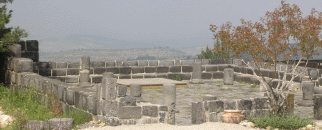One of the more obscure pieces of historical reconstruction of the Israelite settlement of the Canaanite hill country concerns the capture of Jerusalem. Part of the difficulty is that the traces of early accounts have been reworked and integrated into larger narratives by later scribes, for whom the city was profoundly important. They were keen, therefore, to present a national story in which Jerusalem was a major target right from the start. However, the archaeological record of population growth indicates that the central hill country around Shechem was the starting point, with expansion north, west and south from that core. Jerusalem was not central to the early settlers.
 The raw textual material in the Hebrew Bible bearing on Jerusalem is as follows. Judges chapter 1 has two references. In verse 8 we read
The raw textual material in the Hebrew Bible bearing on Jerusalem is as follows. Judges chapter 1 has two references. In verse 8 we read
Then the people of Judah fought against Jerusalem and took it. They put it to the sword and set the city on fire.
Thus sounds quite straightforward. But then in verse 21 we find
But the Benjaminites did not drive out the Jebusites who lived in Jerusalem; so the Jebusites have lived in Jerusalem among the Benjaminites to this day.
So a different tribe, and a report of failure rather than success. Joshua 15, while listing the territorial boundaries of the various tribes, has the following in verse 62
But the people of Judah could not drive out the Jebusites, the inhabitants of Jerusalem; so the Jebusites live with the people of Judah in Jerusalem to this day.
So it’s failure again, this time linked specifically to Judah. The uncertainty about these two tribes is logical, since the city was on the border between the lands claimed by them.
Back in Joshua 10 we find a battle record in which the king of Jerusalem was one of several who were defeated in the open field. This chapter – seen predominantly from the perspective of the town of Kephrath, originally on the Canaanite side – forms the background to part of the novel In a Milk and Honeyed Land. The book, however, scales the battle down to a size more typical of Late Bronze encounters than Iron Age ones, and we have representatives of the kings present rather than the kings themselves.
In Joshua 12 we are reminded that the king of Jerusalem was one of many who had been defeated. It is worth remembering as we read this list that the typical city-state ruler of this time would command at most tens of troops, and Egyptian garrisons could effectively control the region with a handful of men. The real issue was not numbers, but military technology and the circumstances of the battle.
After these texts, all from the early days after the Israelite arrival, there is almost nothing until David captures it considerably later, in the book of Samuel. In between we have scant mention of the city, and that purely as a geographical reference point.
What are we to make of this? It seems clear that there was no successful early capture of Jerusalem, despite the upbeat message of Judges 1:8. If there were real attempts to capture the city this early on, they were failures. But should they even be seen as real attempts? Archaeologically, the early Israelite settlement was in small villages scattered in the central hill country. It is not at all clear that the settlers had any interest in cities, except as landmarks to describe regions of control. Only later did the relative strengths of Israelite villager and Canaanite city dweller change sufficiently to make an assault possible. Encounters in the open field, especially when circumstances favoured an ambush or other ruse, were one thing: direct attacks on cities were another.
Archaeological exploration of Jerusalem has been very limited over the years. Clearly it would be highly desirable to know more, but this is almost impossible because of the continuous occupation of the city, and the huge complications arising from the sensibilities of three major religions. So reconstruction relies heavily on textual information, including the rather earlier letters written by Abdi-Heba, king of Jerusalem, to the Egyptian pharaoh.
We have no independent witness to the accounts in the Hebrew Bible that might help reconcile this, so are forced back onto weighing probabilities. My own suspicion is that there was neither the intention nor the ability on the Israelite part to capture Jerusalem early on. The fringes of the city – or perhaps the outlying daughter villages – might well have been raided. Perhaps some houses or storage areas were set alight in anger or frustration, but a serious assault was out of the question. Not only was Jerusalem too powerful for this to be realistically considered, but the Israelites, with small scattered settlements close to the city on almost every side, could not afford to begin hostilities they could not end. Jerusalem would remain solidly Canaanite for a long time. Later scribes, with a different agenda, retold these early skirmishes as though they were larger and more significant, but were clearly unwilling to gloss them completely into overwhelming victories.
The Flame Before Us is set in this period of uncertainty. The cities are, by and large, too strong for the Israelites to face head on. A serious external threat, or the muscle-flexing of one of the regions many city rulers, is altogether too much to be confronted. It is better to avoid conflict rather than face it, unless a way can be found to turn some feature of the ground or the circumstances into advantage.
